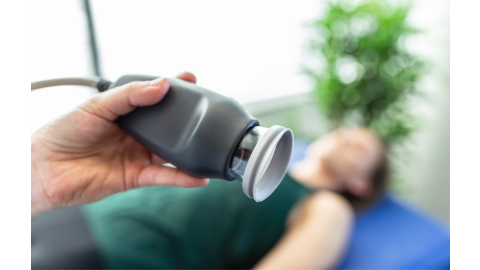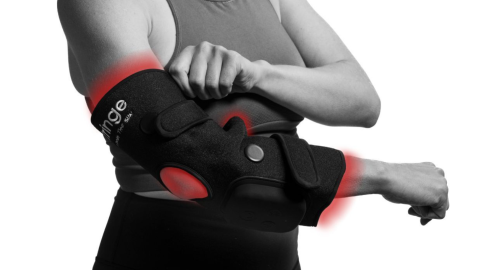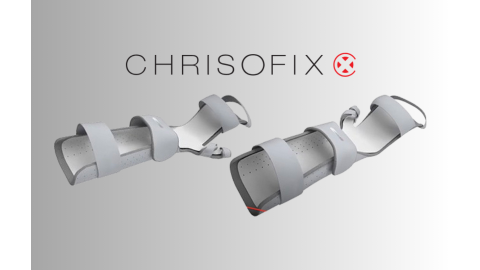Football players account for 71% of all male ACL injuries in high school athletes. If you play, coach, or treat football players, there’s a lot of information you should know about ACL sprains and tears.
What is your ACL and how does it tear?
The Anterior Cruciate Ligament (ACL) is one of four cruciate ligaments located in the knee. It connects the femur to the tibia through the center of the knee. This stabilizes the knee while moving. The ACL is the main ligament used when planting and cutting, a common football maneuver to “fake out” an opponent. It is also the most commonly injured cruciate ligament.

Two Common Causes of ACL Injuries in Football:
- A player is hit in the knee causing hyperextension. The foot is usually planted in the ground leaving the knee unable to move freely and then the knee is hit.
- In non-contact injuries, the player is often pushing off the ground and changing direction at the same time. Hard cuts like this are a common cause of ACL tears and injuries.
ACL injuries range from mild sprains to tears and are measured on a 1 to 3 scale, one being mild instability and low severity, three requiring surgical repair. ACL injuries can take more than a year to fully recover from, but with proper rehabilitation and physical therapy, many players can safely reduce that recovery time to under a year.
There are numerous symptoms associated with ACL tears, including:
- Severe knee pain
- A popping noise and sudden feeling of instability
- Swelling
- Inability to put weight on the knee
Many of these symptoms are also common in more mild knee injuries like strains and sprains. If you experience any of them, it’s best to contact your athletic trainer or doctor right away.
ACL Injury Risk Factors
One significant factor is the type of turf that surfaces the field. FieldTurf is the predominant artificial turf from high school to professional levels, and while it has many benefits, one drawback is a slightly higher risk of ACL injury.
Another field factor is whether the playing surface is wet or dry. Dry conditions have been shown to put players at greater risk of injury than wet conditions. This is possibly due to players’ lack of cutting ability when it’s wet, meaning that they are more likely to lose footing before cutting hard enough to sustain an ACL injury.
Having a history of ACL injuries can also be another indicator of increased risk for future injuries. In professional football players, 18.3% of ACL injuries occurred in a knee that had previously been injured.
Positional Factors
Each field position has different levels of risk associated with it due to the specific movement players are required to perform. This means that some positions are putting more force on the knee and make up a large portion of the ACL injuries at a professional level.
Offense
Offensive skill players are among the most likely to suffer ACL injuries. The hard cuts and changes in direction required of tight ends and receivers make them especially susceptible to ACL injuries. On the line: tackles have a very low rate of ACL injuries; the interior linemen are at a much higher risk; guards being the highest risk players at the professional level.
Defense
Linebackers have the highest ACL injury rates out of all defensive players. Between covering tight ends and tackling running backs, linebackers are pushing their bodies to the limit, often at the detriment of their knees. Meanwhile, defensive backs and defensive ends are both below average in incidences of ACL injuries per player.

Preventing ACL Injuries
One of the first steps in preventing ACL injuries is talking to an athletic trainer or physical therapist. Trainers can show players the best practices and optimal form for maintaining knee health.
Dr. Trent Nessler is a great example of the importance of athletic trainers. He tested his ACL Injury Prevention Program at Troy University in conjunction with the football team. This program, which uses wearable sensors to determine the risk of injury, led to a 58% decrease in non-contact injuries. Most schools aren’t implementing programs like Nessler’s, but an athletic trainer is the best source of accurate information for preventing injuries.
Knee braces can also be used to increase stability while playing and practicing. Dr. David Chao, who has worked countless NFL players, recommended knee braces for all of his players. Some players prefer a brace like the Rolyan ACL Brace that offers maximum support while others choose a brace like the Rolyan Hinged Knee Brace that allows for a wider range of motion.
ACL Repair Surgery
ACL surgery is typically recommended to athletes or anyone who plans on putting extensive force on the ACL again after the recovery. If the ligament is torn, it will be replaced with part of a similar tendon from the knee or a donated ligament from a cadaver. This is done through a small incision in the knee. Patients can typically leave on the same day as the surgery and will be on crutches for a few weeks afterward.
ACL Injury Recovery and Rehabilitation
After suffering an ACL injury, proper rehabilitation is crucial for a safe and effective recovery. The first stop should always be a physical therapist or athletic trainer. They can give players a detailed guide on exercise regimens designed for getting back to the field. A progressive system of exercises using resistance bands can be a good starting point for post-operative workouts.
As the rehabilitation progresses, athletes will slowly be able to increase the range of motion in their knee. To ensure that the knee isn’t flexed too far, trainers will often recommend a brace that measures and limits degrees of extension and flexion. These braces can be locked to set specific limits on the movement of the knee. As the knee is rehabbed, these limits can be extended for increased motion.
ACL injuries will often leave the knee feeling sore and weak. The pain can range from mild discomfort to severe pain. There are a number of ways to safely treat this pain without impeding the recovery process.
A brace that applies heat, such as the Hyperice Venom, can be used to relax the muscles and joints around the knee if they are feeling stiff. This is especially useful as individuals move into the rehabilitation process and are pushing the range of motion of their knee farther.
As patients begin to stretch the knee throughout the rehabilitation process, some soreness can be expected. An effective way to treat this pain is with compression and icing. Braces that apply compression and ice the knee, like the HyperIce Compression are an easy way to get the combined pain relief of cryotherapy and compression all at once.
Simple solutions like reusable ice packs and Biofreeze gel are also great for short-term pain relief.
As a football player, ACL injuries are common, but with the right tools and proper guidance from a therapist or trainer, you can recover and get back on the field.
References
Chao, David. (2017, August). There is no increased ACL epidemic in NFL, but also no way to ensure decrease. SanDiegoUnionTribune.com. Retrieved from https://bit.ly/2xqPmrT
Department of Orthopaedic Surgery, Lenox Hill Hospital. (2012, September). An analysis of specific lower extremity injury rates on grass and FieldTurf. NCBI.gov. Retrieved from https://bit.ly/2Nr9qlm
Dodson, Christopher. (2016, March). Anterior Cruciate Ligament Injuries in National Football League Athletes From 2010 to 2013. NCBI.gov. Retrieved from https://bit.ly/2LtCDeX
Med Sports Systems. (1997, December). A review of selected noncontact anterior cruciate ligament injuries in the National Football League. NCBI.gov. Retrieved from https://bit.ly/2uwt88l
Moore, Rebecca. (2016, August). ACL Injury Prevention Kit Makes Waves in Collegiate Football. PerformanceHealth.com. Retrieved from https://bit.ly/2Nr7eKE
The Ohio State University, College of Medicine, (2013, November-December). A Multisport Epidemiologic Comparison of Anterior Cruciate Ligament Injuries in High School Athletics. NCBI.gov. Retrieved from https://bit.ly/2mnNufe
Wedro, Benjamin. (2017, November). Torn ACL. eMedicineHealth.com. Retrieved from https://bit.ly/2uInK0O
Medical Disclaimer: The information provided on this site, including text, graphics, images and other material, are for informational purposes only and are not intended to substitute for professional medical advice, diagnosis or treatment. Always seek the advice of your physician or other healthcare professional with any questions or concerns you may have regarding your condition.








 France
France Australia
Australia





